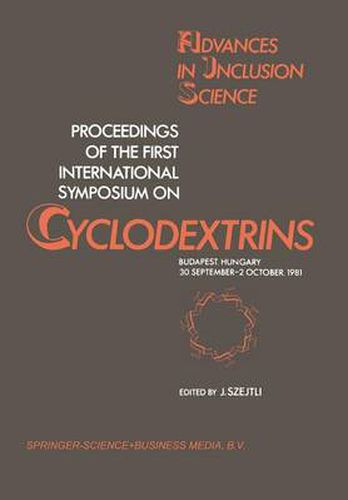Readings Newsletter
Become a Readings Member to make your shopping experience even easier.
Sign in or sign up for free!
You’re not far away from qualifying for FREE standard shipping within Australia
You’ve qualified for FREE standard shipping within Australia
The cart is loading…






This title is printed to order. This book may have been self-published. If so, we cannot guarantee the quality of the content. In the main most books will have gone through the editing process however some may not. We therefore suggest that you be aware of this before ordering this book. If in doubt check either the author or publisher’s details as we are unable to accept any returns unless they are faulty. Please contact us if you have any questions.
Cyclodextrins are galnlng industrial interest owing to their particu- lar structure. These cyclic amyloses are commonly composed of 6, 7 or 8 (named a-, 8-, y-CD) glucose units. They undergo complexation with quite a large number of substances by molecular inclusion. Their potential for in- dustrial application is substantiated by their ability to protect fragile substances from oxygen and UV, to delay the evolution of volatiles and to aid the ancillary processing of dangerous or volatile substances in powder- ed form. Though a-, 8- and y-CD exhibit different inclusion specificity, 8-CD has found more attention than the others. This is due to the fact that most of the cyclodextrin producing enzymes known produce predominantly 8-CD. Fur- thermore 8-CD is by far the least soluble form, leading to a relatively sim- ple production and purification. Consequently 8-CD is already in production on an industrial scale [~] while a- and 8-CD are still more or less re- garded as specialities. A further CD-producing enzyme has been found in the medium of K. pneu- moniae [l], Since this CGT appeared to produce predominantly a-CD [~], it has been chosen to develop a process for the production of a-CD. MATERIALS AND METHODS Analysis of cyclodextrins: HPLC on Lichrosorb-NH . 10 ~m, with acetonitrile 2 water 65/35 per volume. Test for CGT activity: as described by Landert elsewhere in this Volume. Starch: potato starch as obtained from Blattmann, Wadenswil, Switzerland.
$9.00 standard shipping within Australia
FREE standard shipping within Australia for orders over $100.00
Express & International shipping calculated at checkout
This title is printed to order. This book may have been self-published. If so, we cannot guarantee the quality of the content. In the main most books will have gone through the editing process however some may not. We therefore suggest that you be aware of this before ordering this book. If in doubt check either the author or publisher’s details as we are unable to accept any returns unless they are faulty. Please contact us if you have any questions.
Cyclodextrins are galnlng industrial interest owing to their particu- lar structure. These cyclic amyloses are commonly composed of 6, 7 or 8 (named a-, 8-, y-CD) glucose units. They undergo complexation with quite a large number of substances by molecular inclusion. Their potential for in- dustrial application is substantiated by their ability to protect fragile substances from oxygen and UV, to delay the evolution of volatiles and to aid the ancillary processing of dangerous or volatile substances in powder- ed form. Though a-, 8- and y-CD exhibit different inclusion specificity, 8-CD has found more attention than the others. This is due to the fact that most of the cyclodextrin producing enzymes known produce predominantly 8-CD. Fur- thermore 8-CD is by far the least soluble form, leading to a relatively sim- ple production and purification. Consequently 8-CD is already in production on an industrial scale [~] while a- and 8-CD are still more or less re- garded as specialities. A further CD-producing enzyme has been found in the medium of K. pneu- moniae [l], Since this CGT appeared to produce predominantly a-CD [~], it has been chosen to develop a process for the production of a-CD. MATERIALS AND METHODS Analysis of cyclodextrins: HPLC on Lichrosorb-NH . 10 ~m, with acetonitrile 2 water 65/35 per volume. Test for CGT activity: as described by Landert elsewhere in this Volume. Starch: potato starch as obtained from Blattmann, Wadenswil, Switzerland.